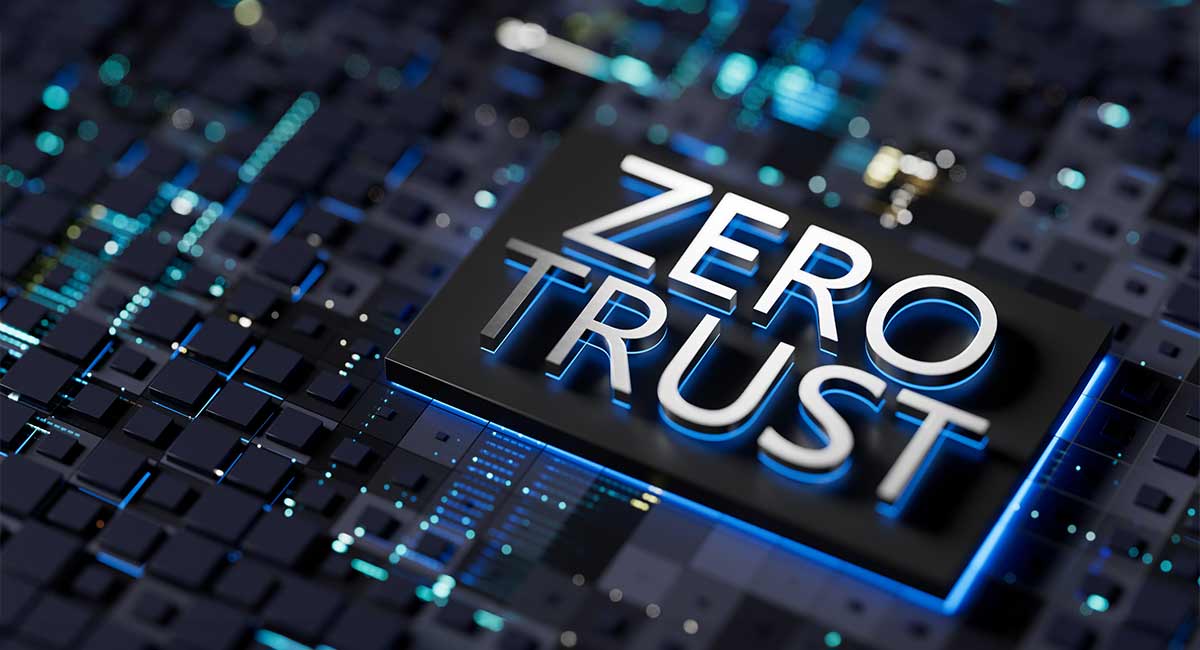All people, businesses, governments, and public organizations are in the crosshairs of cybercriminals today. It’s imperative to take new approaches to cybersecurity as the world becomes more connected and digitized. Enter zero trust security.
This blog will answer the question: “What is zero trust security?” It will take a deep dive into this increasingly critical security model, how it works, its benefits, principles and best practices, and real-world industry applications. You’ll also learn how to gain the required skills and practical experience implementing zero trust security through a comprehensive, forward-thinking online cybersecurity program.
Let’s begin with a high-level definition.
What is Zero Trust Security?
Zero trust security is a strategic approach to cybersecurity that operates on the principle “never trust, always verify.” This paradigm shift in security architecture is designed to address the evolving challenges and threats in today’s digital landscape, where traditional perimeter-based security models are no longer sufficient. Unlike conventional methods that implicitly trust users and devices within a network’s perimeter, zero trust treats all users, devices, and network traffic as potentially hostile, regardless of their location—inside or outside the organization’s network.
At its core, zero trust security requires rigorous identity verification, strict access control, and continuous network activity monitoring. This holistic approach encompasses various technologies and practices, including multi-factor authentication (MFA), least privilege access, micro-segmentation, and endpoint security, to minimize the attack surface and mitigate the risk of unauthorized access and data breaches.
The adoption of zero trust security is driven by the need to protect critical data and systems in the face of sophisticated cyber threats, the proliferation of remote work, and the increasing use of cloud services. Zero trust security provides a more adaptive and effective defense against the constantly evolving cyber threat landscape by assuming that threats can originate from anywhere and that every access request is a potential risk.
Also Read: Reviewing Careers in Cybersecurity in 2024
How Does Zero Trust Security Work?
Implementing zero trust security involves integrating various technology solutions, such as identity and access management (IAM) systems, endpoint security tools, encryption technologies, and security information and event management (SIEM) systems. These technologies work together to authenticate, authorize, and continuously monitor access requests and activities across the network.
Zero trust security is a dynamic, adaptive approach that evolves with the threat landscape, ensuring that organizations can protect their critical assets in the face of increasingly sophisticated cyber threats. Its emphasis on verification, minimal access, and continuous monitoring represents a significant shift from traditional security models, offering a more granular and effective defense mechanism against potential security breaches.
Principles of Zero Trust Security
Zero trust security operates on a comprehensive framework that incorporates various principles and technologies to ensure the security of an organization’s data and systems. Its methodology can be distilled into several vital components that work together to create a robust security posture:
As a foundational element of zero trust security, several core principles guide its implementation and ensure its effectiveness in safeguarding digital assets. These principles underscore the shift from traditional, perimeter-based security models to a more holistic, data-centric approach that assumes threats can come from anywhere. Here’s a breakdown of these guiding principles:
1. Never Trust, Always Verify
At the heart of Zero trust is the axiom to “never trust, always verify.” This principle challenges the conventional security model’s assumption that everything inside an organization’s network can be trusted. Instead, zero trust treats all access requests with skepticism, requiring verification regardless of the source’s location.
2. Least Privilege Access
This principle ensures that users, systems, and devices are granted only the access necessary to perform their functions. Limiting permissions to the minimum required can minimize the potential impact of a breach or attack.
3. Micro-Segmentation
Micro-segmentation involves dividing network resources into secure zones to control access and movement within the network. This approach allows for more granular security policies, limiting an attacker’s ability to move laterally across the network.
4. Continuous Monitoring and Validation
Zero trust security mandates continuous monitoring of network and system activities to detect and respond to threats in real time. This principle supports the dynamic validation of security configurations and postures, ensuring trust levels are constantly evaluated and adjusted based on observed behavior.
5. Secure Access Control
Implementing strict access control measures is crucial under zero trust. This involves authenticating and authorizing every user and device before granting access to resources, using strong authentication methods and context-aware policies.
6. Explicit Verification
Every attempt to access a system’s resources must be explicitly verified, with no implicit trust granted based on location (inside or outside the network) or asset ownership. Verification encompasses the identity of users and devices and the health and security posture.
7. Data-centric Security
Zero trust protects data throughout its lifecycle, regardless of where it resides or moves—within on-premises environments, across mobile devices, or through cloud services. Encryption, data loss prevention (DLP), and other data-centric security measures are critical components of this principle.
8. Holistic Security Strategy
Rather than relying on a single technology or solution, zero trust requires a holistic approach that integrates various security measures and technologies across the organization. This unified strategy ensures comprehensive coverage and resilience against cyber threats.
These principles of zero trust security coalesce into a robust framework designed to protect modern digital environments against sophisticated threats. By adhering to these guidelines, organizations can create a resilient security posture that adapts to the evolving landscape of cyber risks.
Also Read: Best Practices for Cybersecurity: A 2024 Guide
Benefits of Implementing Zero Trust Security
Adopting zero trust security offers many benefits for organizations navigating the complex and evolving cyber threat landscape. This security model enhances the protection of critical data and systems and supports business continuity and resilience. Here are some of the key advantages:
Enhanced Security Posture
Zero trust security significantly reduces the attack surface by implementing strict access controls and continuously verifying every access request, regardless of its origin. This approach limits the opportunities for attackers to exploit vulnerabilities, thereby enhancing the overall security posture of an organization.
Improved Compliance and Data Protection
Zero trust helps organizations meet regulatory compliance requirements more effectively by emphasizing data-centric security practices. The model’s principles ensure that sensitive information is encrypted, access is tightly controlled, and data is monitored, aiding in the protection of personally identifiable information (PII), financial data, and intellectual property.
Reduced Risk of Insider Threats
The principle of least privilege and continuous monitoring inherent in zero trust mitigates the risk posed by insider threats. By granting users access only to the resources they need and scrutinizing their activities, organizations can detect and respond to suspicious behaviors before they result in data breaches or other security incidents.
Scalability and Flexibility
Zero trust security is designed to be flexible and scalable, accommodating the dynamic nature of modern business environments. Its framework supports the secure adoption of cloud services, mobile computing, and remote work, making it easier for organizations to adapt to changing business needs and technological advancements.
Enhanced Visibility and Control
The continuous monitoring and micro-segmentation strategies of zero trust give organizations greater visibility into their networks and more granular control over resource access. This enhanced oversight allows for the early detection of anomalies and swift action to mitigate potential threats, ensuring a more proactive security stance.
Streamlined Security Operations
Implementing a zero trust model can lead to more streamlined and efficient security operations. By automating verification processes and employing advanced security technologies, organizations can reduce manual workload, minimize human error, and expedite the response to security incidents.
Business Enablement
Finally, zero trust security can be a significant enabler for business, facilitating secure digital transformation initiatives, enhancing customer trust, and enabling the secure sharing of data within ecosystems of partners and vendors. By ensuring a high level of security, organizations can confidently pursue innovation and growth.
In summary, zero trust security fortifies defenses against external and internal threats and supports compliance, operational efficiency, and business agility. Its adoption represents a strategic investment in building a resilient, future-proof security infrastructure that aligns with the demands of the digital age.
Real-World Industry Use Cases of Zero Trust Security
The zero trust security model has been adopted by various organizations across industries, demonstrating its versatility and effectiveness in addressing contemporary security challenges. Below are some real-world use cases that illustrate how zero trust principles can be applied to enhance security and operational efficiency.
Financial Services: Protecting Sensitive Customer Data
Banks and financial institutions face stringent regulatory requirements and the constant threat of data breaches. A major bank could secure customer transactions and sensitive data across its global network by implementing zero trust. The use of multi-factor authentication (MFA) and micro-segmentation ensured that access to financial records was strictly controlled and monitored, significantly reducing the risk of fraud and data theft.
Healthcare: Securing Patient Information
A healthcare provider implemented zero trust to protect patient records and ensure compliance with health information privacy regulations. Through the enforcement of least privilege access and continuous monitoring, the provider could safeguard sensitive health data against unauthorized access, while still allowing healthcare professionals to access the information they needed to deliver patient care.
Government: Defending Against Cyber Threats
Government agencies responsible for handling sensitive national security information have turned to zero trust to bolster their defenses against sophisticated cyber espionage activities. By adopting a zero trust architecture, an agency could segment its networks, enforce strict access controls, and monitor for anomalies, thereby improving its ability to detect and respond to cyber threats.
Education: Ensuring Secure Remote Learning
The shift to remote learning posed significant security challenges for educational institutions. One university adopted a zero trust framework to securely manage access to educational resources for students and faculty, regardless of their location. Implementing MFA and continuously verifying user identities and device security postures enabled the university to provide a secure and flexible learning environment.
Retail: Safeguarding Customer Transactions
A retail giant implemented zero trust to protect its e-commerce platform against data breaches and ensure the security of customer transactions. By applying micro-segmentation principles and least privilege, the retailer created secure zones for payment processing and customer data, significantly mitigating the risk of data breaches and enhancing customer trust.
Manufacturing: Protecting Intellectual Property
In the manufacturing sector, protecting intellectual property (IP) is paramount. A manufacturing company applied zero trust security measures to protect its designs and patents from industrial espionage. By controlling access to sensitive data and continuously monitoring for suspicious activity, the company was able to secure its IP and maintain its competitive advantage.
These use cases demonstrate the flexibility and effectiveness of zero trust security in protecting organizations against a wide range of cyber threats. By adopting Zero Trust principles, organizations across various sectors can enhance their security posture, comply with regulatory requirements, and support their business objectives in the face of evolving digital challenges.
Also Read: How To Get Into Cybersecurity in 2024? A Complete Guide
Best Practices for Implementing Zero Trust Security
Zero trust security is a strategic decision requiring careful planning and execution. To ensure a successful implementation and maximize the benefits of this security model, organizations should adhere to the following best practices:
1. Conduct a Comprehensive Security Audit
Begin by assessing your current security posture, including identifying sensitive data, mapping data flows, and understanding potential vulnerabilities. This audit will help you understand where to focus your Zero Trust implementation efforts.
2. Implement Strong Identity and Access Management (IAM)
Central to Zero Trust is robust IAM. Implement multi-factor authentication (MFA), single sign-on (SSO), and identity federation to ensure that only authenticated users can access your systems. Regularly review and update access permissions to reflect changes in roles and responsibilities.
3. Adopt Least Privilege Access Control
Ensure that users, applications, and systems have only the access they need to perform their tasks. This minimizes the potential impact of a breach by limiting the attacker’s ability to move laterally within your network.
4. Use Micro-Segmentation to Protect Network Resources
Divide your network into secure zones using micro-segmentation. This allows for more granular control over traffic flow and more effective isolation of sensitive data and systems, reducing the risk of widespread network breaches.
5. Leverage Endpoint Security Solutions
Ensure that all devices accessing the network are secure and compliant with your organization’s security policies. Use endpoint detection and response (EDR) tools and regular patch management to keep devices secure.
6. Monitor and Analyze Security Data Continuously
Employ security information and event management (SIEM) tools to collect and analyze data from various sources within your network. Continuous monitoring helps detect and respond to real-time threats, a zero trust core principle.
7. Educate and Train Your Workforce
Awareness and training are crucial for the success of a zero trust implementation. Educate your employees about the principles of Zero Trust and train them on security best practices, phishing prevention, and safe online behaviors.
8. Collaborate with Vendors and Partners
Ensure that your vendors and partners also adhere to zero trust principles, especially when they require access to your network. Establish clear security requirements and conduct regular audits to ensure compliance.
9. Iterate and Improve Continuously
Zero Trust is not a “set it and forget it” model. Continuously assess your security measures, respond to new threats, and improve your security posture. Stay informed about the latest security technologies and practices that can enhance your Zero Trust framework.
By following these best practices, organizations can effectively implement zero trust security, enhancing their ability to protect against cyber threats while supporting their business objectives.
Master Cybersecurity Methods of the Future
Cybersecurity threats are only going to increase. That’s why organizations of all stripes need skilled professionals to implement the strictest and most up-to-date security protocols, processes, and standards available. If you want to gain the skills and knowledge to become a professional in this high-demand and rewarding field, consider enrolling in a comprehensive cybersecurity bootcamp led by top industry and academic leaders.
According to ZipRecruiter, the average annual salary of a cybersecurity professional is $132,962.
You might also like to read:
Cybersecurity Job Description: A Complete Guide
How to Build and Implement Cybersecurity Skills
How to Become a Cybersecurity Engineer? A Complete Guide






